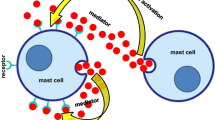Abstract
IgE-anti-IgE complexes were formed by preincubation of a human myeloma IgE with a monoclonal anti-human IgE antibody at different concentrations. Binding of IgE onto the anti-IgE inhibited the histamine release capacity of anti-IgE from basophils. The IgE cell-binding capacity was altered by the IgE/anti-IgE ratio in the preincubation buffer. Heating of the complexes gave a partial recovery of the anti-IgE degranulating capacity, suggesting that the monoclonal anti-IgE is specific for an epitope present on the Dɛ2 domain.
Similar content being viewed by others
References
S. G. O. Johansson,Anti-IgE antibodies in human serum. J. Allergy clin. Immunol.77, 555–557 (1986).
R. C. Williams jr., R. W. Griffiths, J. D. Emmons and R. C. Field,Naturally occurring human antiglobulins with specificity for E. J. clin. Invest.51, 955–963 (1972).
S. G. O. Johansson and H. Bennich,Immunological studies of an atypical myeloma immunoglobulin. Immunology13, 381–394 (1967).
W. M. Hunter and F. C. Greenwood,Preparation of Iodine 131 labelled human growth hormone of high specific activity. Nature194, 495–496 (1962).
J. P. Bourgeois, M. Pere, J. C. Mazie and J. F. Delagneau,Monoclonal anti bodies to human IgE: Utilization for total IgE, quantification and estimation of allergen specific IgE antibodies. Develop. Biol. Standard. vol. 57, pp. 371–379 (S. Karger, Basel) (1984).
M. Ceska, R. Eriksson and J. M. Varga,Radioimmunosorbent assay of allergens. J. Allergy clin. Immunol.,49, 1–9 (1972).
A. Weyer, J. P. Dandeu, F. Marchand and B. David,In vitro histamine release from human basophils triggered by a purified allergen from Dermatophagoides farinae: bimodal aspect of the dose response curve. Ann. Immunol. (Inst. Pasteur)133D, 87–94 (1982).
A. Weyer, P. Ougen, J. P. Dandeu, F. Marchand and B. David,Passive in vitro sensitization of human basophils with Dermatophagoides farinae specific IgE. Agents and Actions18, 178–181 (1986).
M. Inganas, S. G. O. Johansson and H. Bennich,Anti-IgE antibodies in human serum: Occurrence and specificity. Int. Archs Allergy appl. Immun.65, 51–61 (1981).
C. Demeulemester, A. Weyer, G. Peltre, M. Laurent, F. Marchand and B. David,Thermoinactivation of human IgE: antigenic and functional modifications. Immunology7, 617–620 (1986).
Author information
Authors and Affiliations
Rights and permissions
About this article
Cite this article
Weyer, A., Demeulemester, C., Mazie, J.C. et al. Monoclonal anti-human IgE: histamine release capacity and effect onin vitro sensitization of human basophils. Agents and Actions 20, 206–209 (1987). https://doi.org/10.1007/BF02074670
Issue Date:
DOI: https://doi.org/10.1007/BF02074670




